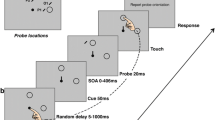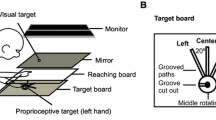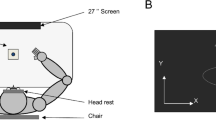Abstract
Human movements are remarkably adaptive. We are capable of completing movements in a novel visuomotor environment with similar accuracy to those performed in a typical environment. In the current study, we examined if the control processes underlying movements under typical conditions were different from those underlying novel visuomotor conditions. 16 participants were divided into two groups, one receiving continuous visual feedback during all reaches (CF), and the other receiving terminal feedback regarding movement endpoint (TF). Participants trained in a virtual environment by completing 150 reaches to three targets when (1) a cursor accurately represented their hand motion (i.e., typical environment) and (2) a cursor was rotated 45° clockwise relative to their hand motion (i.e., novel environment). Analyses of within-trial measures across 150 reaching trials revealed that participants were able to demonstrate similar movement outcomes (i.e., movement time and angular errors) regardless of visual feedback or reaching environment by the end of reach training. Furthermore, a reduction in variability across several measures (i.e., reaction time, movement time, time after peak velocity, and jerk score) over time showed that participants improved the consistency of their movements in both reaching environments. However, participants took more time and were less consistent in the timing of initiating their movements when reaching in a novel environment compared to reaching in a typical environment, even at the end of training. As well, angular error variability at different proportions of the movement trajectory was consistently greater when reaching in a novel environment across trials and within a trial. Together, the results suggest a greater contribution of offline control processes and less effective online corrective processes when reaching in a novel environment compared to when reaching in a typical environment.






Similar content being viewed by others
References
Abahnini K, Proteau L, Temprado JJ (1997) Evidence supporting the importance of peripheral visual information for the directional control of aiming movements. J Mot Behav 29(3):230–242
Aboelnasr EA, Hegazy FA, Altalway HA (2017) Kinematic characteristics of reaching in children with hemiplegic cerebral palsy: a comparative study. Brain Inj 31(1):83–89
Alberts JL, Saling M, Adler CH, Stelmach GE (2000) Disruptions in the reach-to-grasp actions of Parkinson’s patients. Exp Brain Res 134(3):353–362
Batcho CS, Gagné M, Bouyer LJ, Roy JS, Mercier C (2016) Impact of online visual feedback on motor acquisition and retention when learning to reach in a force field. Neuroscience 337:267–275
Bernier P-M, Chua R, Franks IM, Khan MA (2006) Determinants of offline processing of visual information for the control of reaching movements. J Mot Behav 38(5):331–338
Burkitt JJ, Grierson LEM, Straite V, Elliott D, Lyons J (2013) The impact of prior knowledge about visual feedback on motor performance and learning. Adv Phys Educ 3(1):1–9
Cheng DT, Luis M, Tremblay L (2008) Randomizing visual feedback in manual aiming: reminiscence of the previous trial condition and prior knowledge of feedback availability. Exp Brain Res 189(4):403–410
Clower DM, Boussaoud D (2000) Selective use of perceptual recalibration versus visuomotor skill acquisition. J Neurophysiol 84(5):2703–2708
de Grosbois J, Tremblay L (2016) Quantifying online visuomotor feedback utilization in the frequency domain. Behav Res Methods 48(4):1653–1666
de Grosbois J, Tremblay L (2018) Distinct and flexible rates of online control. Psychol Res 82(6):1054–1072
Desmurget M, Grafton S (2000) Forward modeling allows feedback control for fast reaching movements. Trends Cogn Sci 4(11):423–431
Elliott D, Allard F (1985) The utilization of visual feedback information during rapid pointing movements. Q J Exp Psychol Sect A 37(3):407–425
Elliott D, Lee TD (1995) The role of target information on manual-aiming bias. Psychol Res 58(1):2–9
Elliott D, Carson R, Goodman D, Chua R (1991) Discrete vs. continuous visual control of manual aiming. Hum Mov Sci 10:393–418
Elliott D, Binsted G, Heath M (1999) The control of goal-directed limb movements: correcting errors in the trajectory. Hum Mov Sci 18:121–136
Elliott D, Helsen WF, Chua R (2001) A century later: Woodworth’s (1899) two-component model of goal-directed aiming. Psychol Bull 127(3):342–357
Elliott D, Hansen S, Mendoza J, Tremblay L (2004) Learning to optimize speed, accuracy, and energy expenditure: a framework for understanding speed-accuracy relations in goal-directed aiming. J Mot Behav 36(3):339–351
Elliott D, Hansen S, Grierson LEM, Lyons J, Bennett SJ, Hayes SJ (2010) Goal-directed aiming: two components but multiple processes. Psychol Bull 136(6):1023–1044
Elliott D, Dutoy C, Andrew M, Burkitt JJ, Grierson LEM, Lyons JL, … Bennett SJ (2014) The influence of visual feedback and prior knowledge about feedback on vertical aiming strategies. J Mot Behav 46(6):433–443
Elliott D, Lyons J, Hayes SJ, Burkitt JJ, Roberts JW, Grierson LEM, … Bennett SJ (2017) The multiple process model of goal-directed reaching revisited. Neurosci Biobehav Rev 72:95–110
Fernandez-Ruiz J, Wong W, Armstrong IT, Flanagan JR (2011) Relation between reaction time and reach errors during visuomotor adaptation. Behav Brain Res 219:8–14
Gaveau V, Prablanc C, Laurent D, Rossetti Y, Priot A-E (2014) Visuomotor adaptation needs a validation of prediction error by feedback error. Front Human Neurosci 8:880
Ghilardi MF, Gordon J, Ghez C (1995) Learning a visuomotor transformation in a local area of work space produces directional biases in other areas. J Neurophysiol 73(6):2535–2539
Grierson LEM, Elliott D (2008) Kinematic analysis of goal-directed aims made against early and late perturbations: an investigation of the relative influence of two online control processes. Hum Mov Sci 27:839–856
Grierson LEM, Elliott D (2009) Goal-directed aiming and the relative contribution of two online control processes. Am J Psychol 122(3):309–324
Hansen S, Glazebrook CM, Anson JG, Weeks DJ, Elliott D (2006) The influence of advance information about target location and visual feedback on movement planning and execution. Can J Exp Psychol 60(3):200–208
Hay JC, Pick HL (1966) Gaze-contingent prism adaptation: optical and motor factors. J Exp Psychol 72(5):640–648
Heath M (2005) Role of limb and target vision in the online control of memory-guided reaches. Mot Control 9:281–311
Heath M, Hodges NJ, Chua R, Elliott D (1998) On-line control of rapid aiming movements: Unexpected target perturbations and movement kinematics. Can J Exp Psychol 52(4):163–173
Hinder MR, Riek S, Tresilian JR, de Rugy A, Carson RG (2010) Real-time error detection but not error correction drives automatic visuomotor adaptation. Exp Brain Res 201:191–207
Huberdeau DM, Haith AM, Krakauer JW (2015a) Formation of a long-term memory for visuomotor adaptation following only a few trials of practice. J Neurophysiol 114(2):969–977
Huberdeau DM, Krakauer JW, Haith AM (2015b) Dual-process decomposition in human sensorimotor adaptation. Curr Opin Neurobiol 33:71–77
Jeannerod M (1986) Are corrections in accurate arm movements corrective? Prog Brain Res 64(C):353–360
Kantak SS, Winstein CJ (2012) Learning-performance distinction and memory processes for motor skills: a focused review and perspective. Behav Brain Res 228(1):219–231
Khan MA, Elliott D, Coull J, Chua R, Lyons J (2002) Optimal control strategies under different feedback schedules: kinematic evidence. J Mot Behav 34(1):45–57
Khan MA, Lawrence G, Fourkas A, Franks IM, Elliott D, Pembroke S (2003) Online versus offline processing of visual feedback in the control of movement amplitude. Acta Physiol (Oxf) 113:83–97
Khan MA, Franks IM, Elliott D, Lawrence GP, Chua R, Bernier PM et al (2006) Inferring online and offline processing of visual feedback in target-directed movements from kinematic data. Neurosci Biobehav Rev 30:1106–1121
Krakauer JW, Ghilardi M-F, Ghez C (1999) Independent learning of internal models for kinematic and dynamic control of reaching. Nat Neurosci 2(11):1026–1031
Krakauer JW, Pine ZM, Ghilardi M-F, Ghez C (2000) Learning of visuomotor transformations for vectorial planning of reaching trajectories. J Neurosci 20(23):8916–8924
Leow L-A, Gunn R, Marinovic W, Carroll TJ (2017) Estimating the implicit component of visuomotor rotation learning by constraining movement preparation time. J Neurophysiol 118(2):666–676
Maksimovic S, Cressman EK (2018) Long-term retention of proprioceptive recalibration. Neuropsychologia 114(March):65–76
Mendoza JE, Elliott D, Meegan DV, Lyons JL, Welsh TN (2006) The effect of the Müller-Lyer illusion on the planning and control of manual aiming movements. J Exp Psychol Hum Percept Perform 32(2):413–422
McDougle SD, Ivry RB, Taylor JA (2016) Taking aim at the cognitive side of learning in sensorimotor adaptation tasks. Trends Cogn Sci 20(7):535–544
Meyer DE, Abrams RA, Kornblum S, Wright CE, Smith JEK (1988) Optimality in human motor performance: Ideal control of rapid aimed movements. Psychol Rev 95(3):340–370
Oldfield RC (1971) The assessment and analysis of handedness: the Edinburgh inventory. Neuropsychologia 9:97–113
Posner MI, Nissen MJ, Klein RM (1976) Visual dominance: an information-processing account of its origins and significance. Psychol Rev 83(2):157–171
Redding GM, Wallace B (1996) Adaptive spatial alignment and strategic motor control. J Exp Biol Human Percept Perform 22(2):379–394
Redding GM, Wallace B (2002) Strategic calibration and spatial alignment. J Mot Behav 34(2):126–138
Redding GM, Wallace B (2006) Generalization of prism adaptation. J Exp Psychol Hum Percept Perform 32(4):1006–1022
Redding GM, Rossetti Y, Wallace B (2005) Applications of prism adaptation: A tutorial in theory and method. Neurosci Biobehav Rev 29(3):431–444
Sainburg RL, Wang J (2002) Interlimb transfer of visuomotor rotations: Independence of direction and final position information. Exp Brain Res 145:437–447
Sarlegna FR, Sainburg RL (2009) The roles of vision and proprioception in the planning of reaching movements. Adv Exp Med Biol 629:317–335
Schmidt RA, Zelaznik HN, Hawkins B, Frank JS, Quinn JT Jr (1979) Motor-output variability: a theory for the accuracy of rapid motor acts. Psychol Rev 86(5):415–451
Scott SH (2016) A functional taxonomy of bottom-up sensory feedback processing for motor actions. Trends Neurosci 39(8):512–526
Shabbott BA, Sainburg RL (2010) Learning a visuomotor rotation: Simultaneous visual and proprioceptive information is crucial for visuomotor remapping. Exp Brain Res 203(1):75–87
Simon A, Bock O (2016) Influence of movement kinematics on visuomotor adaptation. Exp Brain Res 234:3083–3090
Smeets JBJ, van den Dobbelsteen JJ, de Grave DDJ, van Beers RJ, Brenner E (2006) Sensory integration does not lead to sensory calibration. Proc Natl Acad Sci 103(49):18781–18786
Smith MA, Ghazizadeh A, Shadmehr R (2006) Interacting adaptive processes with different timescales underlie short-term motor learning. PLoS Biol 4(6):1035–1043
Taylor JA, Ivry RB (2011) Flexible cognitive strategies during motor learning. PLoS Comput Biol 7(3):e1001096
Taylor JA, Krakauer JW, Ivry RB (2014) Explicit and implicit contributions to learning in a sensorimotor adaptation task. J Neurosci 34(8):3023–3032
Teulings H-L, Contreras-Vidal JL, Stelmach GE, Adler CH (1997) Parkinsonism reduces coordination of fingers, wrist, and arm in fine motor control. Exp Neurol 146(1):159–170
Tremblay L, Hansen S, Kennedy A, Cheng DT (2013) The utility of vision during action: multiple visuomotor processes? J Mot Behav 45(2):91–99
Tseng Y-W, Diedrichsen J, Krakauer JW, Shadmehr R, Bastian AJ (2007) Sensory prediction errors drive cerebellum-dependent adaptation of reaching. J Neurophysiol 98(1):54–62
van der Kooij K, Brenner E, Van Beers RJ, Smeets JBJ (2015) Visuomotor adaptation: how forgetting keeps us conservative. PLoS One 10(2):1–13
Walsh CM, Ling SC, Wang CS, Carnahan H (2009) Concurrent versus terminal feedback: it may be better to wait. Acad Med 84(10):S54–S57
Wang J, Lei Y (2015) Direct-effects and after-effects of visuomotor adaptation with one arm on subsequent performance with the other arm. J Neurophysiol 114(1):468–473
Wolpert DM, Kawato M (1998) Multiple paired forward and inverse models for motor control. Neural Netw 11:1317–1329
Woodworth RS (1899) The best movement for handwriting author(s. Sci New Ser 10(254):679–681
Yamamoto K, Hoffman DS, Strick PL (2006) Rapid and long-lasting plasticity of input-output mapping. J Neurophysiol 96:2797–2801
Zbib B, Henriques DYP, Cressman EK (2016) Proprioceptive recalibration arises slowly compared to reach adaptation. Exp Brain Res 234:2201–2213
Zelaznik HN, Hawkins B, Kisselburgh L (1983) Rapid visual feedback processing in single-aiming movements. J Mot Behav 15(3):217–236
Funding
This research was supported by the Natural Sciences and Engineering Research Council of Canada awarded to Erin K. Cressman.
Author information
Authors and Affiliations
Corresponding author
Ethics declarations
Conflict of interest
All authors declare that they have no conflict of interest.
Additional information
Publisher’s Note
Springer Nature remains neutral with regard to jurisdictional claims in published maps and institutional affiliations.
Electronic supplementary material
Below is the link to the electronic supplementary material.
Rights and permissions
About this article
Cite this article
Wijeyaratnam, D.O., Chua, R. & Cressman, E.K. Going offline: differences in the contributions of movement control processes when reaching in a typical versus novel environment. Exp Brain Res 237, 1431–1444 (2019). https://doi.org/10.1007/s00221-019-05515-0
Received:
Accepted:
Published:
Issue Date:
DOI: https://doi.org/10.1007/s00221-019-05515-0




